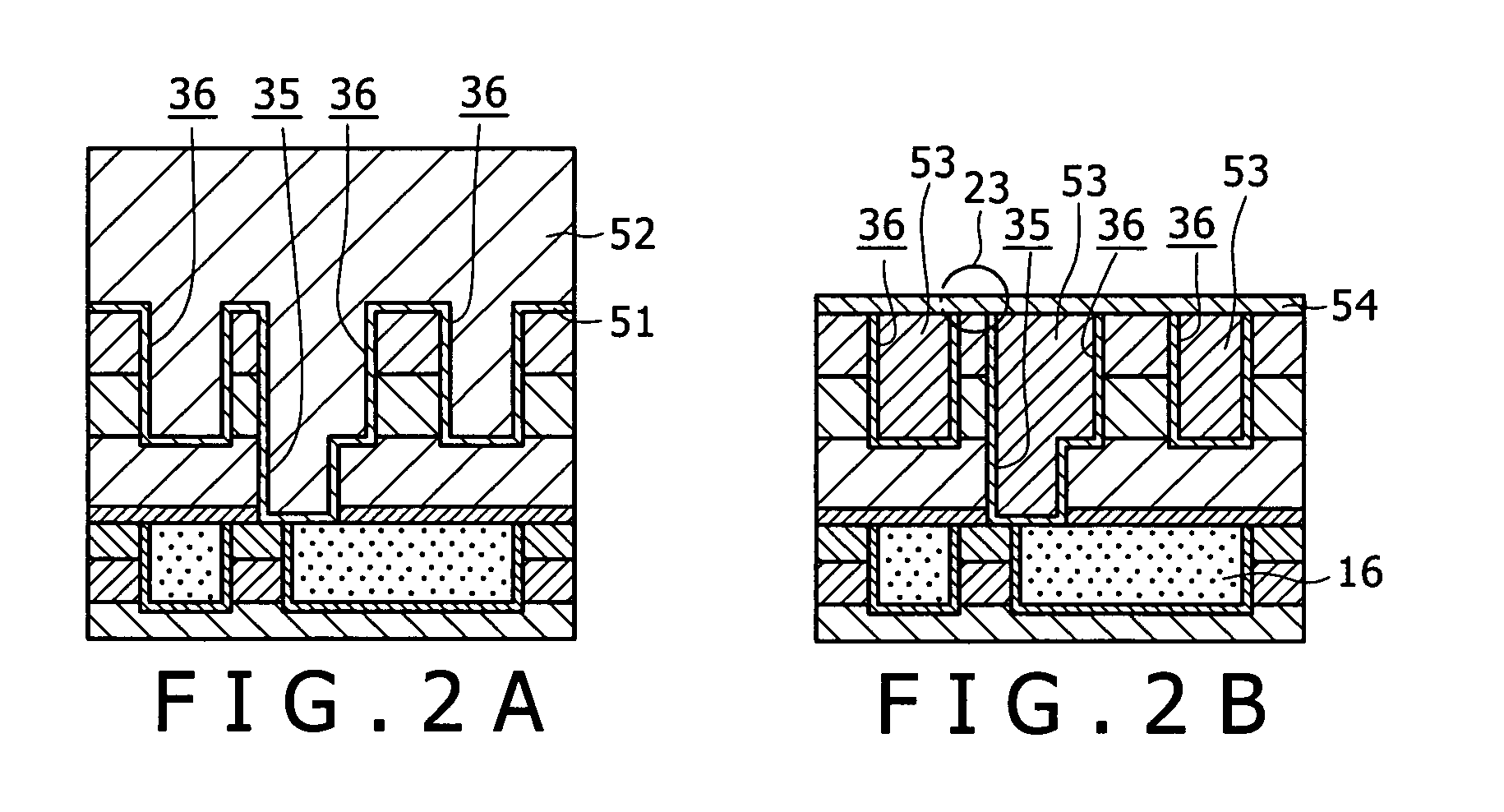Method of manufacturing semiconductor device
a manufacturing method and semiconductor technology, applied in the direction of semiconductor devices, basic electric elements, electrical appliances, etc., can solve the problems of increasing lowering the resistance reducing the stability of the connection hole, so as to achieve the dual damascene processing. , the effect of easy carrying ou
- Summary
- Abstract
- Description
- Claims
- Application Information
AI Technical Summary
Benefits of technology
Problems solved by technology
Method used
Image
Examples
first embodiment
[0044] A first embodiment of the method of manufacturing a semiconductor device according to the present invention will be described referring to manufacturing step sectional views shown in FIGS. 1A to 1F and FIGS. 2A and 2B.
[0045] As shown in FIG. 1A, an interlayer insulation film 12 is formed on an under insulation film 11 deposited on a substrate (not shown). The interlayer insulation film 12 is formed, for example, by forming a laminate film including an organic film 13 and a silicon oxide (SiO2) film 14. The interlayer insulation film 12 is provided with a first wiring 16 in wiring grooves 15, with a close contact layer, a barrier metal layer or the like therebetween. The first wiring 16 is formed to have a wiring thickness of about 150 nm by burying a copper (Cu) film, for example. In addition, an oxidation inhibitive layer 17 is formed on the first wiring 16. The oxidation inhibitive layer 17 is formed, for example, by forming a silicon carbide (SiC) film in a thickness of 3...
second embodiment
[0072] A second embodiment of the method of manufacturing a semiconductor device according to the present invention will be described referring to manufacturing step sectional views shown in FIGS. 3A to 3F and FIGS. 4A and 4B. While in the embodiment 1 the prevention of shortcircuit defects between the wiring and the connection holes and the securing of the withstand voltage were realized by improving the corner collapse shape of the wiring grooves through the laminate etching mask structure including the organic sacrificing layer, in the cases of the 32 nm generation and the latter generations there is a need for miniaturization on the order of half-pitch≦60 nm and a dielectric constant reduction on the order of dielectric constant≦2.2. In view of this, in the second embodiment, based on the manufacturing method in the embodiment 1, one example of a method of manufacturing a multi-layer wiring through a groove wiring structure applicable to the formation of a wiring with a minute p...
third embodiment
[0101] A third embodiment of the method of manufacturing a semiconductor device according to the present invention will be described referring to manufacturing step sectional views shown in FIGS. 5A to 5F and FIGS. 6A and 6B. While the manufacturing method in the so-called hybrid low dielectric constant film structure in which an organic film (for example, a polyaryl ether film) is sandwiched between the wiring layers has been described in the embodiments 1 and 2 above, the present invention is applicable also to the cases of other low dielectric constant film structures. Here, an example of application to a low dielectric constant film structure based primarily on an SiOC film will be described.
[0102] As shown in FIG. 5A, an interlayer insulation film 12 is formed on an under insulation film 11 deposited on a substrate (not shown). The interlayer insulation film 12 is formed, for example, by forming a laminate film composed of an organic film 13 and a silicon oxide (SiO2) film 14....
PUM
 Login to View More
Login to View More Abstract
Description
Claims
Application Information
 Login to View More
Login to View More - R&D
- Intellectual Property
- Life Sciences
- Materials
- Tech Scout
- Unparalleled Data Quality
- Higher Quality Content
- 60% Fewer Hallucinations
Browse by: Latest US Patents, China's latest patents, Technical Efficacy Thesaurus, Application Domain, Technology Topic, Popular Technical Reports.
© 2025 PatSnap. All rights reserved.Legal|Privacy policy|Modern Slavery Act Transparency Statement|Sitemap|About US| Contact US: help@patsnap.com



